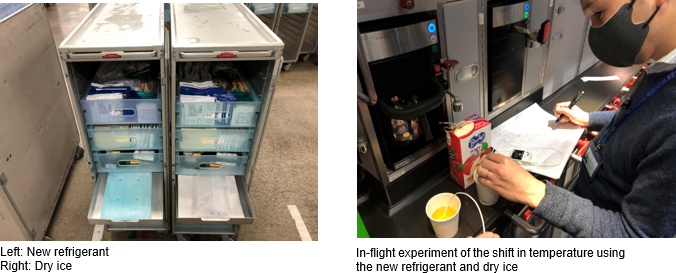All Nippon Airways (ANA) will adopt a new way*1 to cool in-flight meals and beverages on all domestic flights to reduce CO2 emissions and operating costs.
At ANA, the dry ice traditionally used in the in-flight carts of domestic flights to cool the in-flight meals and beverages lead to an annual CO2 emission of approximately 1,700 tons*2. From April 2020, ANA began studying the introduction of alternative refrigerants and through testing the cooling effect, temperature maintenance, and impact on the quality of the cooled goods on flights and in regular situations, we decided to switch from dry ice to a new refrigerant.
The newly introduced refrigerant is made of material used as food additives, which is harmless for humans and will help maintain the in-flight meals and beverages at a stable temperature with its capability to maintain cool for a long period of time. In addition, by using the same device repeatedly, the amount of packaging materials used with dry ice will be reduced by about 30 tons per year, which is expected to cut costs by about 200 million yen per year (about 80 percent). Furthermore, as there is less risk of frostbite compared to the handling of dry ice, the new alternative is a sustainable approach for the global environment, economy, and safety.
"This change brings ANA another step closer to achieving our sustainability goals addressed in the ANA Future Promise," said Junko Yazawa, Senior Vice President overseeing Customer Experience Management & Planning. "It will benefit the environment and reduce costs while ensuring that ANA passengers continue to enjoy quality food and beverages."
The introduction of the new refrigerant is part of the ANA's environmental, social and governance (ESG) initiatives embodied in the ANA Future Promise effort to achieve net zero emissions by 2050. ANA has announced the 2050 goal earlier this year in an ambitious update of its 2020 ESG targets. The airline also established new medium-term environmental targets for fiscal 2030 as part of its path to the 2050 benchmark.
- 1: The new eco-friendly refrigerant is the “Fujiyama18,” manufactured by Japan Cold Chain Co Ltd.
- 2: Comparison to the amount of dry ice used in FY2019.
 Take our user survey and make your voice heard.
Take our user survey and make your voice heard.















5 Comments
Login to comment
starpunk
Any eco-friendly method is a good one. Thing is, most alky beverages aren't too cold anyway and at such high elevations, it's too easy to get 'blitzed on the bird'.
ShinkansenCaboose
Nope, outside air is out of the question due to decompression and adding holes into the fragile air frame.
Desert Tortoise
How about a heat exchanger located near the skin using a NACA duct to direct cold outside air across coils or a radiator sort of device to cool a liquid that in turn would cool the galley refrigerators? As for the "fragile airframe" comment I have to laugh. There are already multiple penetrations for the pitot-static system, wiring bundles, hydraulic lines and flight controls that are successfully sealed. There are whole clamshell doors at the rear of military cargo aircraft that seal and allow pressurization.
Pukey2
Yes, come to think of it, that's a fair question.
divinda
The cruising altitude of a standard commercial airplane is about 35,000 feet (11,000 meters).
This altitude is usually reached within the first 10 minutes of flight.
At this altitude, the air temperature is between -40 degrees and -60 degrees (use either F or C on that one, since at such frigid temps, its nearly the same).
Can't this ultra-coldness that is as eco-friendly as you can get in some way be harnessed instead of convoluted refrigeration techniques?